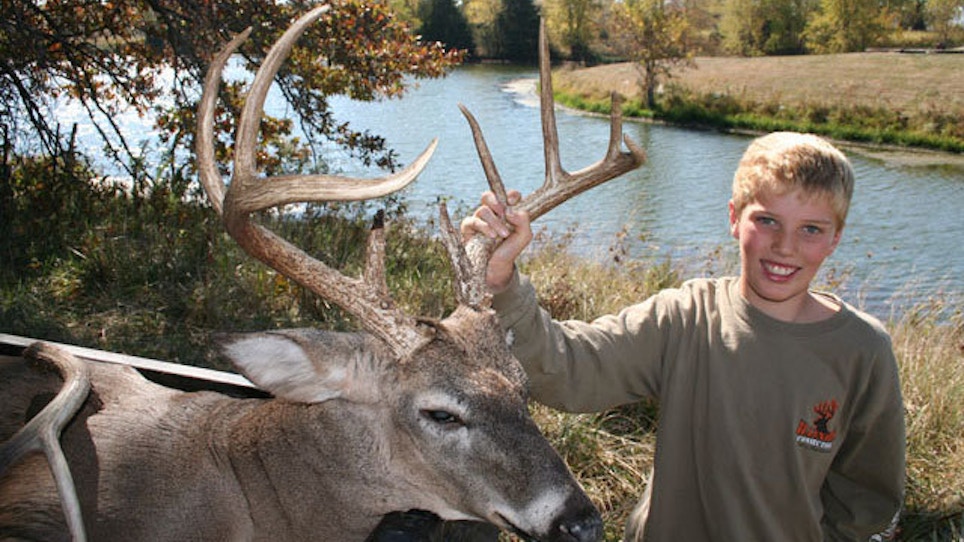After charting Illinois’ best buck kills from more than three past decades, I wrote a magazine article in the early ’90s. This feature included an illustration that told the story in a glance. Ten Lincoln Land counties, all encompassed between the Illinois and Mississippi Rivers on Illinois’ west side, produced twice as many Boone and Crockett bucks as the state’s 92 other counties. The explanation was simple. These two major rivers and hundreds of their sandwiched feeder tributaries — creeks and smaller rivers — provide perfect habitat for whitetails to grow healthy and old.
Yes, there were two other factors to this equation. Western Illinois has less human population than the rest of the state, and the terrain there has a favorable blend of crops, oak timber and set-aside. The magazine diagram depicting the super-producing counties was dubbed “Illinois’ Trophy Triangle.” Eventually this region became better known as “Illinois’ Golden Triangle.”
Most states and provinces in the whitetail’s continental range have their own regional version of a Trophy Triangle. For Wisconsin, it’s Buffalo County along the Mississippi River. This area, too, has an excellent whitetail landscape that’s interwoven with small tributaries, agricultural and set-aside fields, and dense woodlands. The Ohio River, flanking the southeastern tip of Illinois and also forming the southern boundary of Indiana and Ohio and the northern border of Kentucky, grows great whitetail bucks in bordering counties. Without a doubt, Nebraska’s best big-buck hunting is along the Platte River. Missouri’s honeyhole counties start on the western side along the Missouri River and get progressively better as the Missouri meets the Mississippi on the state’s eastern side.
Iowa’s greatest wealth in big whitetails falls in the southeastern portion of the state between two Mississippi River tributaries, the De Moines and Chariton Rivers. In addition to these rivers having an abundance of flanking tributaries, this between-the-rivers region was once booming cattle country. Agricultural income was supplemented here by raising cattle. From the early to mid 20th century, hundreds of livestock ponds were built in this 5,000-square-mile whitetail area. This had a noticeable disbursement effect on whitetails.
In 50-plus years of hunting whitetails, all the exceptional trophy spots I’ve ever uncovered had direct links to identifiable water sources. Herbivores need water, no different than humans. Most of their required moisture intake comes from succulent vegetation — plants are 50 to 90 percent water. But during hot, dry summers, warm ruts, and below-freezing winter days, whitetails need to drink from open water.
Many studies contend that mature whitetails often base their home range around a water source. In arid regions like Texas, this could be a single cattle pond or holding tank. In the Midwest, a home range might center on a creek or river basin or a manmade or natural lake or pond. Based on knowledge of the needs of domestic livestock, it’s believed that deer require twice as much water ingestion in the summer than the winter — about 3 quarts per 100 pounds of body weight as opposed to 1 ½ quarts in the winter. This is slightly less than what is recommended for a human. The difference lies mostly in the fact that deer do not sweat like we do. Lactating does and growing fawns and yearlings require considerably more water than mature bucks that simply maintain body mass.
Deer are not fussy when it comes to where they drink. Their bodies have longstanding immunities to most waterborne bacteria, algae and parasites found in stagnant water. It’s the biting mosquitoes, gnats and midges, thriving on the thresholds of standing water, that have adverse effects on whitetails, a sidebar topic in this article.
When insects grow annoying in the damp woods and around water sources, mature bucks begin camping out in agricultural crops to avoid the onslaught of biting insects. Since they can survive with less water, it would not be uncommon for them to spend most of the summer within the confines of a standing corn field. Many midsummer days I’ve seen bucks bed all day in stands of soybeans and milo, a 95-degree sun beating down on them, preferring this over enduring the constant badgering of insects in the shade of a woodlot.
Most bucks 3 years of age and older can be found within the same 50 to 100 acres an entire summer. Their small summer range will always include the closeness of an open water source. In the Corn Belt, a mature buck only occasionally visits water during early summer when crops are succulent with new growth. In drought years or after crops begin maturing, they make regular trips to water in the cool of late night when insects are less active.
Hunting Near Water
It seems reasonable to most hunters to set up an ambush near water when lots of tracks prove the consistent visits of deer. While I was giving a trail camera seminar, an Ohio hunter asked, “I’m hunting a creek crossing where my trail camera took hundreds of photos of a half-dozen nice bucks that were using this area before the season opener. After two weeks into the bow season, I had not seen more than a couple does and fawns there. Disappointed, I pulled my stand. Where did the bucks go?”
Though answering a question like this is always speculation without knowing the area and the ability of the hunter, this was my best guess: Humidity near streams or ponds is higher than normal, which gives a whitetail’s nose an edge. Without odor particles floating on tiny beads of moisture and collecting on a deer’s nose, whitetails are oblivious to stealth hunters.
Most tributaries are in low areas with contiguous tree lines. Leaves would still have been on trees in Ohio’s early bow season. Swirling or no wind near the Buckeye hunter’s stand site could have warned whitetails of his presence well before they were within view. And once deer recognize a danger zone, they will habitually wind-test that area before entering it thereafter.
Hunt low-lying areas near water only after leaf cover has dropped and on days with a rising barometer. This will give residual human scents a chance to rise above a deer’s nose. A falling barometer means that air is beginning to dampen with precipitation. Saturating air favors guarded whitetails.
Stream-based bucks are there for multiple reasons: to get a drink, of course, but adjacent areas also hold fertile soil that is usually farmed, and that provides easily accessed food. Sometimes the only oak trees with acorns during a drought year are those growing adjacent to a stream bed. Thick vegetation along watercourses also provides great hideouts after crops are harvested. It’s tough approaching these brushy tree lines through an open field without being discovered.
One of the most effective ruses for harvesting a smart, streamside buck is a water approach. Walking the edge of a creek or river to enter an ambush site before daybreak is sometimes the only feasible method to remain undetected. This regularly requires a longer trek in and more preparation, but the payoff is worth the effort!
Water And The Rut
Especially during early stages of the rut, when young bucks constantly chase, both they and badgered does seek out open water to replace loss through panting and profuse salivating. Elevated body temperature from exertion forces thirst, thus whitetails instinctively drink to avoid the consequences of dehydration. Higher levels of the actual drinking of water curtails appetite, also a known occurrence in humans. This, and the focused attention on procreation, causes bucks to lose weight. So how does knowing this offer any kind of an advantage to smart hunters?
During warm ruts, harassed does are quite willing to expose themselves in the open to lap water from a field pond. Seems they know that bucks prefer some level of concealment — at least in the early stages of rut. Though young bucks will drink about anywhere offering some cover, mature bucks, I’ve found, favor small mud holes in thickets; what I call tadpole pools. These are often overgrown cattle ponds, long forgotten, not maintained.
Sitting in a treestand all day during the rut, staring at a tiny pool of water surrounded by dense cover, can be a bit boring — until a monster appears at point-blank range. Then the wait becomes worth the prize!






